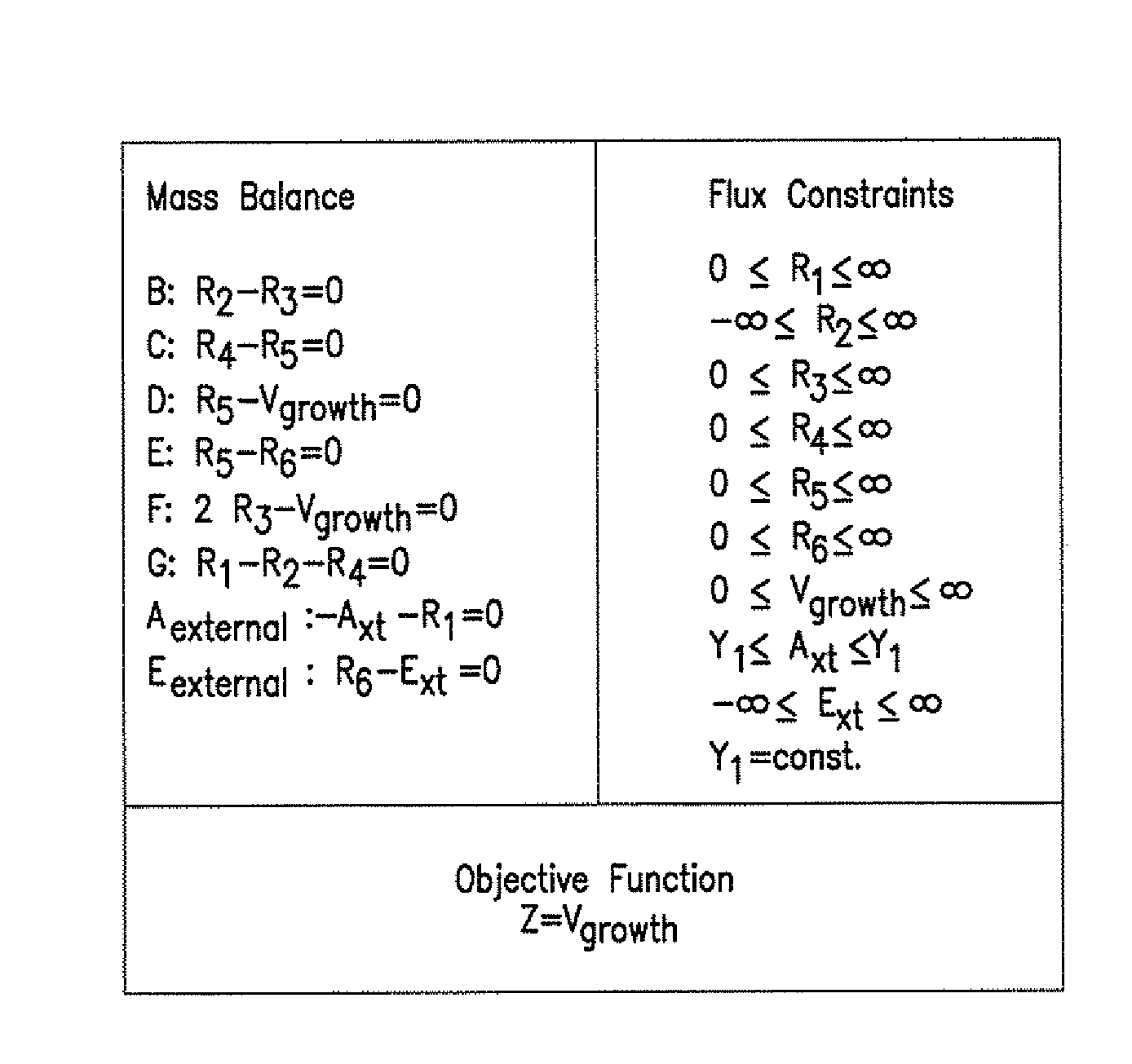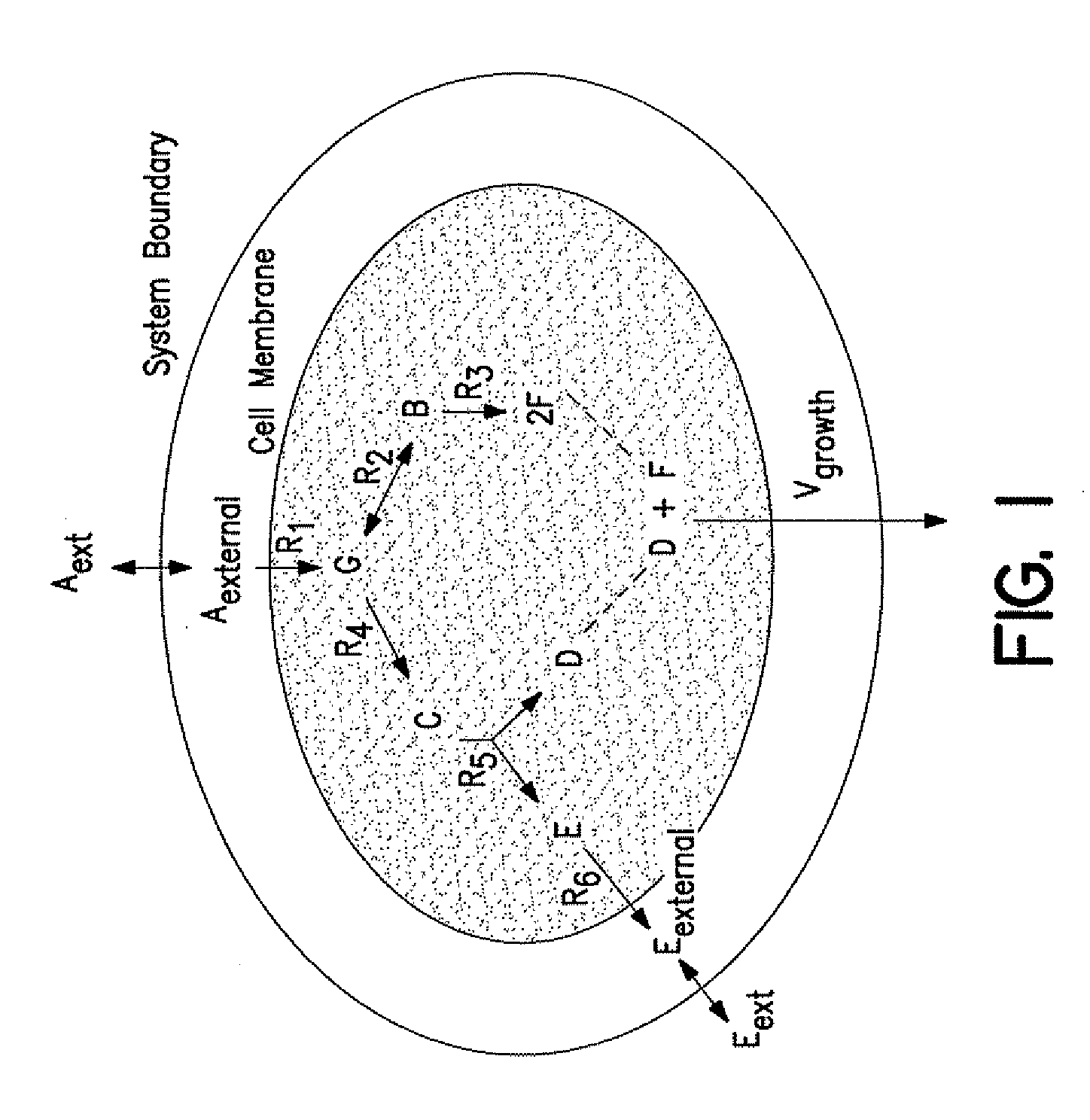Compositions and Methods for Modeling Saccharomyces cerevisiae Metabolism
a technology of saccharomyces cerevisiae and reaction network, applied in the field of computational methods for simulating and predicting the activity of saccharomyces cerevisiae (s . cerevisiae) reaction network, can solve the problems of not being guided by a clear understanding, and being difficult to make these kinds of predictions for i>s. cerevisiae /i>
- Summary
- Abstract
- Description
- Claims
- Application Information
AI Technical Summary
Benefits of technology
Problems solved by technology
Method used
Image
Examples
example i
Reconstruction of the Metabolic Network of S. cerevisiae
[0101]This example shows how the metabolic network of S. cerevisiae can be reconstructed.
[0102]The reconstruction process was based on a comprehensive search of the current knowledge of metabolism in S. cerevisiae as shown in FIG. 5. A reaction database was built using the available genomic and metabolic information on the presence, reversibility, localization and cofactor requirements of all known reactions. Furthermore, information on non-growth-dependent and growth-dependent ATP requirements and on the biomass composition was used.
[0103]For this purpose different online reaction databases, recent publications and review papers (Table 5 and 9), and established biochemistry textbooks (Zubay, Biochemistry Wm.C. Brown Publishers, Dubuque, Iowa (1998); Stryer, Biochemistry W.H. Freeman, New York, N.Y. (1988)) were consulted. Information on housekeeping genes of S. cerevisiae and their functions were taken from three main yeast o...
example ii
[0117]Calculation of the P / O Ratio
[0118]This example shows how the genome-scale reconstructed metabolic model of S. cerevisiae was used to calculate the P / O ratio, which measures the efficiency of aerobic respiration. The P / O ratio is the number of ATP molecules produced per pair of electrons donated to the electron transport system (ETS).
[0119]Linear optimization was applied, and the in silico P / O ratio was calculated by first determining the maximum number of ATP molecules produced per molecule of glucose through the electron transport system (ETS), and then interpolating the in silico P / O ratio using the theoretical relation (i.e. in S. cerevisiae for the P / O ratio of 1.5, 18 ATP molecules are produced).
[0120]Experimental studies of isolated mitochondria have shown that S. cerevisiae lacks site I proton translocation (Verduyn et al., Antonie Van Leeuwenhoek 59(1): 49-63 (1991)). Consequently, estimation of the maximum theoretical or “mechanistic” yield of the ETS alone gives a P / ...
example iii
Phenotypic Phase Plane Analysis
[0122]This example shows how the S. cerevisiae metabolic model can be used to calculate the range of characteristic phenotypes that the organism can display as a function of variations in the activity of multiple reactions.
[0123]For this analysis, O2 and glucose uptake rates were defined as the two axes of the two-dimensional space. The optimal flux distribution was calculated using linear programming (LP) for all points in this plane by repeatedly solving the LP problem while adjusting the exchange fluxes defining the two-dimensional space. A finite number of quantitatively different metabolic pathway utilization patterns were identified in the plane, and lines were drawn to demarcate these regions. One demarcation line in the phenotypic phase plane (PhPP) was defined as the line of optimality (LO), and represents the optimal relation between the respective metabolic fluxes. The LO was identified by varying the x-axis (glucose uptake rate) and calcula...
PUM
 Login to View More
Login to View More Abstract
Description
Claims
Application Information
 Login to View More
Login to View More - R&D
- Intellectual Property
- Life Sciences
- Materials
- Tech Scout
- Unparalleled Data Quality
- Higher Quality Content
- 60% Fewer Hallucinations
Browse by: Latest US Patents, China's latest patents, Technical Efficacy Thesaurus, Application Domain, Technology Topic, Popular Technical Reports.
© 2025 PatSnap. All rights reserved.Legal|Privacy policy|Modern Slavery Act Transparency Statement|Sitemap|About US| Contact US: help@patsnap.com



